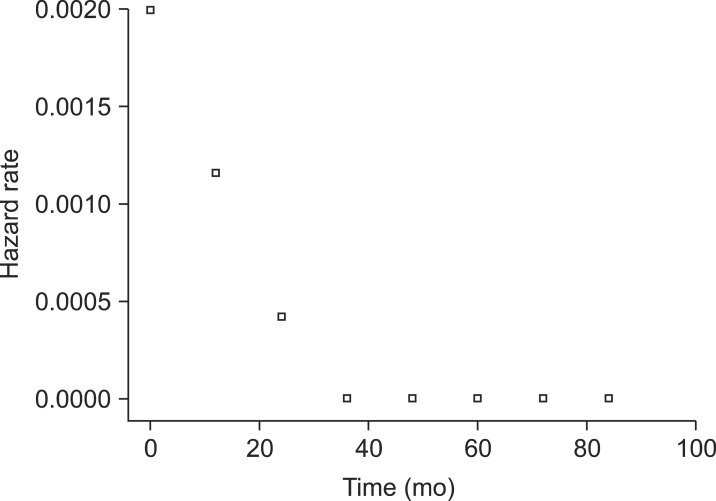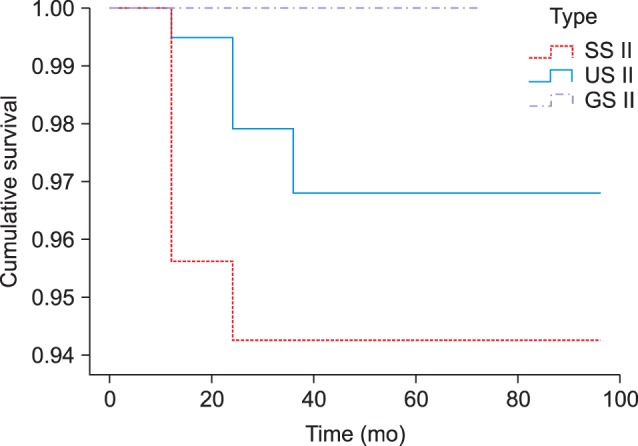J Korean Assoc Oral Maxillofac Surg.
2014 Apr;40(2):68-75. 10.5125/jkaoms.2014.40.2.68.
The seven-year cumulative survival rate of Osstem implants
- Affiliations
-
- 1Department of Oral and Maxillofacial Surgery, Section of Dentistry, Seoul National University Bundang Hospital, Seongnam, Korea.
- 2Department of Orthodontics, Section of Dentistry, Seoul National University Bundang Hospital, Seongnam, Korea.
- 3Department of Prosthodontics, Section of Dentistry, Seoul National University Bundang Hospital, Seongnam, Korea.
- 4Department of Oral and Maxillofacial Surgery, School of Dentistry, Chosun University, Gwangju, Korea. sgckim@chosun.ac.kr
- KMID: 1960957
- DOI: http://doi.org/10.5125/jkaoms.2014.40.2.68
Abstract
OBJECTIVES
This study was performed to analyze the cumulative survival rate of Osstem implants (Osstem Implant Co., Ltd.) over a seven-year period.
MATERIALS AND METHODS
A total of 105 patients who had 467 Osstem implants that were placed at the Section of Dentistry, Seoul National University Bundang Hospital (Seongnam, Korea) from June 2003 through December 2005 were analyzed. The life table method and a cross-tubulation analysis, log rank test were used to evaluate the survival curve and the influence that the prognostic factors. The prognostic factors, i.e., age and gender of patients, diameter and length, type of implants, bone graft history and loading time were determined with a Cox proportional hazard model based on logistic regression analysis.
RESULTS
The seven-year cumulative survival rate of Osstem implants was 95.37%. The Cox proportional hazard model revealed that the following factors had a significant influence on survival rate; increased diameter, reduced prosthetic loading period and performance of bone grafting.
CONCLUSION
The osstem implants showed satisfactory results over the seven-year study period.
Keyword
MeSH Terms
Figure
Cited by 2 articles
-
Analysis of time to failure of orthodontic mini-implants after insertion or loading
Jong-Wha Jeong, Jong-Wan Kim, Nam-Ki Lee, Young-Kyun Kim, Jong-Ho Lee, Tae-Woo Kim
J Korean Assoc Oral Maxillofac Surg. 2015;41(5):240-245. doi: 10.5125/jkaoms.2015.41.5.240.A 5-year prospective clinical study of Neobiotech implants for partially edentulous patients
Wilmart Labriaga, Ju-Hee Hong, Jin-Hong Park, Sang-Wan Shin, Jeong-Yol Lee
J Korean Acad Prosthodont. 2017;55(3):272-278. doi: 10.4047/jkap.2017.55.3.272.
Reference
-
1. Albrektsson T, Zarb G, Worthington P, Eriksson AR. The long-term efficacy of currently used dental implants: a review and proposed criteria of success. Int J Oral Maxillofac Implants. 1986; 1:11–25. PMID: 3527955.2. Arisan V, Bölükbaşi N, Ersanli S, Ozdemir T. Evaluation of 316 narrow diameter implants followed for 5-10 years: a clinical and radiographic retrospective study. Clin Oral Implants Res. 2010; 21:296–307. PMID: 20443792.3. Esposito M, Grusovin MG, Coulthard P, Thomsen P, Worthington HV. A 5-year follow-up comparative analysis of the efficacy of various osseointegrated dental implant systems: a systematic review of randomized controlled clinical trials. Int J Oral Maxillofac Implants. 2005; 20:557–568. PMID: 16161740.4. Cochran DL. A comparison of endosseous dental implant surfaces. J Periodontol. 1999; 70:1523–1539. PMID: 10632528.
Article5. Nasatzky E, Gultchin J, Schwartz Z. The role of surface roughness in promoting osteointegration. Refuat Hapeh Vehashinayim. 2003; 20:8–19. 98PMID: 14515625.6. Summers RB. A new concept in maxillary implant surgery: the osteotome technique. Compendium. 1994; 15:152154–156. 158 passimquiz 162. PMID: 8055503.7. Rosenquist B, Grenthe B. Immediate placement of implants into extraction sockets: implant survival. Int J Oral Maxillofac Implants. 1996; 11:205–209. PMID: 8666452.
Article8. Rocci A, Martignoni M, Gottlow J. Immediate loading of Brånemark System TiUnite and machined-surface implants in the posterior mandible: a randomized open-ended clinical trial. Clin Implant Dent Relat Res. 2003; 5(Suppl 1):57–63. PMID: 12691651.
Article9. Lozada JL. Eight-year clinical evaluation of HA-coated implants. J Dent Symp. 1993; 1:67–69. PMID: 8186844.10. Brechter M, Nilson H, Lundgren S. Oxidized titanium implants in reconstructive jaw surgery. Clin Implant Dent Relat Res. 2005; 7(Suppl 1):S83–S87. PMID: 16137092.
Article11. Bornstein MM, Lussi A, Schmid B, Belser UC, Buser D. Early loading of nonsubmerged titanium implants with a sandblasted and acid-etched (SLA) surface: 3-year results of a prospective study in partially edentulous patients. Int J Oral Maxillofac Implants. 2003; 18:659–666. PMID: 14579953.12. Kim YK, Kim SG, Kim JH, Yi YJ, Yun PY. Prospective study of tapered resorbable blasting media surface implant stability in the maxillary posterior area. Oral Surg Oral Med Oral Pathol Oral Radiol. 2012; 114:e19–e24. PMID: 22732852.
Article13. el Askary AS, Meffert RM, Griffin T. Why do dental implants fail? Part I. Implant Dent. 1999; 8:173–185. PMID: 10635160.
Article14. Romanos GE, Nentwig GH. Immediate versus delayed functional loading of implants in the posterior mandible: a 2-year prospective clinical study of 12 consecutive cases. Int J Periodontics Restorative Dent. 2006; 26:459–469. PMID: 17073356.15. Becktor JP, Isaksson S, Sennerby L. Survival analysis of endosseous implants in grafted and nongrafted edentulous maxillae. Int J Oral Maxillofac Implants. 2004; 19:107–115. PMID: 14982363.16. Shumaker ND, Metcalf BT, Toscano NT, Holtzclaw DJ. Periodontal and periimplant maintenance: a critical factor in long-term treatment success. Compend Contin Educ Dent. 2009; 30:388–390. 392394 passimquiz 407, 418. PMID: 19757733.17. Cavallaro JS Jr. Implant survival and radiographic analysis of proximal bone levels surrounding a contemporary dental implant. Implant Dent. 2011; 20:146–156. PMID: 21448024.
Article18. Stanford CM, Wagner W, Baena RRY, Norton M, McGlumphy E, Schmidt J. Evaluation of the effectiveness of dental implant therapy in a practice-based network (FOCUS). Int J Oral Maxillofac Implants. 2010; 25:367–373. PMID: 20369097.19. Stafford GL. Are the outcomes of immediate and early single tooth implants comparable to conventionally placed implants? Evid Based Dent. 2009; 10:77–78. PMID: 19820741.
Article20. Kook MS, Park HJ, Kim SG, Kim YK, Cho YS, Choi GL, et al. A retrospective multicenter clinical study of installed US II / SS II implants after maxillary sinus floor elevation. J Korean Assoc Oral Maxillofac Surg. 2008; 34:341–349.21. Jeong MA, Kim SG, Kim YK, Oh HK, Cho YS, Kim WC, et al. A multicenter prospective study in type IV bone of a single type of implant. Implant Dent. 2012; 21:330–334. PMID: 22814559.
Article22. Park JH, Lim YJ, Kim MJ, Kwon HB. The effect of various thread designs on the initial stability of taper implants. J Adv Prosthodont. 2009; 1:19–25. PMID: 21165250.
Article23. Alves CC, Neves M. Tapered implants: from indications to advantages. Int J Periodontics Restorative Dent. 2009; 29:161–167. PMID: 19408478.24. Song DW, Lee DW, Kim CK, Park KH, Moon IS. Comparative analysis of peri-implant marginal bone loss based on microthread location: a 1-year prospective study after loading. J Periodontol. 2009; 80:1937–1944. PMID: 19961377.
Article25. Bryant SR. The effects of age, jaw site, and bone condition on oral implant outcomes. Int J Prosthodont. 1998; 11:470–490. PMID: 9922739.26. Smith RA, Berger R, Dodson TB. Risk factors associated with dental implants in healthy and medically compromised patients. Int J Oral Maxillofac Implants. 1992; 7:367–372. PMID: 1289263.27. Heberer S, Hildebrand D, Nelson K. Survival rate and potential influential factors for two transitional implant systems in edentulous patients: a prospective clinical study. J Oral Rehabil. 2011; 38:447–453. PMID: 21070328.
Article28. Renouard F, Nisand D. Impact of implant length and diameter on survival rates. Clin Oral Implants Res. 2006; 17(Suppl 2):35–51. PMID: 16968380.
Article29. Woo VV, Chuang SK, Daher S, Muftu A, Dodson TB. Dentoalveolar reconstructive procedures as a risk factor for implant failure. J Oral Maxillofac Surg. 2004; 62:773–780. PMID: 15218553.
Article30. Sbordone L, Toti P, Menchini-Fabris G, Sbordone C, Guidetti F. Implant survival in maxillary and mandibular osseous onlay grafts and native bone: a 3-year clinical and computerized tomographic follow-up. Int J Oral Maxillofac Implants. 2009; 24:695–703. PMID: 19885411.31. Schliephake H, Neukam FW, Wichmann M. Survival analysis of endosseous implants in bone grafts used for the treatment of severe alveolar ridge atrophy. J Oral Maxillofac Surg. 1997; 55:1227–1233. PMID: 9371112.
Article32. Ivanoff CJ, Gröndahl K, Sennerby L, Bergström C, Lekholm U. Influence of variations in implant diameters: a 3- to 5-year retrospective clinical report. Int J Oral Maxillofac Implants. 1999; 14:173–180. PMID: 10212533.33. Aparicio C, Rangert B, Sennerby L. Immediate/early loading of dental implants: a report from the Sociedad Espaola de Implantes World Congress consensus meeting in Barcelona, Spain, 2002. Clin Implant Dent Relat Res. 2003; 5:57–60. PMID: 12831730.34. Cochran DL, Morton D, Weber HP. Consensus statements and recommended clinical procedures regarding loading protocols for endosseous dental implants. Int J Oral Maxillofac Implants. 2004; 19(Suppl):109–113. PMID: 15635951.35. Weber HP, Morton D, Gallucci GO, Roccuzzo M, Cordaro L, Grutter L. Consensus statements and recommended clinical procedures regarding loading protocols. Int J Oral Maxillofac Implants. 2009; 24(Suppl):180–183. PMID: 19885445.
- Full Text Links
- Actions
-
Cited
- CITED
-
- Close
- Share
- Similar articles
-
- A retrospective study of survival rate of dental implants placed in osteoporosis patients
- Long-term observation of immediately-installed implants after extraction: Retrospective clinical study
- A Retrospective study on the survival rate of the sinus perforated implants
- Effect of the early exposure of cover screws on the survival rate of implants
- A 5-year prospective clinical study of Neobiotech implants for partially edentulous patients




